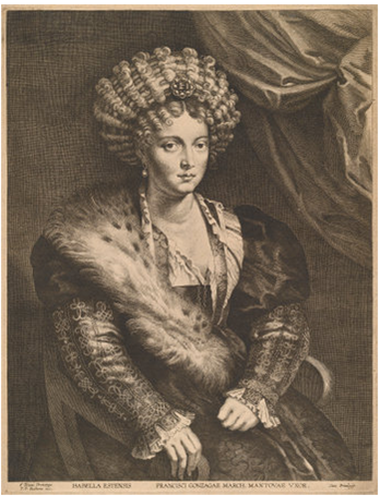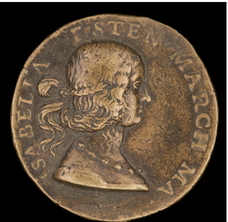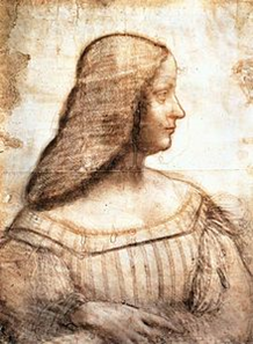 Isabella d’Este, Lucas Emil Vosteman after Sir Peter Paul Rubens, 1595-1675 CE, engraving, Rosenwald Collection, 1950.14.450 Courtesy
National Gallery of Art, Washington.
Isabella d’Este, Lucas Emil Vosteman after Sir Peter Paul Rubens, 1595-1675 CE, engraving, Rosenwald Collection, 1950.14.450 Courtesy
National Gallery of Art, Washington.
Isabella d’Este, 1474-1539
Order of Medieval Women Appendix D, Appendix E
Daughter of Ercole I, Duke of Ferrara and Modena, wife to Gian Francesco Gonzaga. Isabella was a powerful, well-educated political figure, the eldest child born into Italy’s most aristocratic medieval nobility, a ruling family present in Ferrara since the eleventh century. Following her father’s example as a patron of the arts and humanities, she was a learned woman equipped with a humanist education, actively promoting the arts and learning in her court. With great poise and self-control, enormously charming with immense energy, intelligent with a force of character and astute at achieving her ends she excelled in statecraft becoming known for a non-confrontational approach to foreign policy. She dealt ably with diplomats and ruled Mantua as regent for her husband from 1509-1512 while he was held hostage abroad. Upon her husband’s death in 1519, she remained the power behind the scenes during the reign of her son Federico II and saw the promotion of her second son Ercole to cardinal. During the May 1527 sacking of Rome Isabella was given advance warning to barricade herself in her Santi Apostoli Palace until troops could be sent to protect her. Against their instructions she kept her gates open for several hours allowing over 2,000 people to seek refuge, her palace was the only major palace in the city that remained unharmed.
Order of Medieval Women Appendix D, Appendix E
Daughter of Ercole I, Duke of Ferrara and Modena, wife to Gian Francesco Gonzaga. Isabella was a powerful, well-educated political figure, the eldest child born into Italy’s most aristocratic medieval nobility, a ruling family present in Ferrara since the eleventh century. Following her father’s example as a patron of the arts and humanities, she was a learned woman equipped with a humanist education, actively promoting the arts and learning in her court. With great poise and self-control, enormously charming with immense energy, intelligent with a force of character and astute at achieving her ends she excelled in statecraft becoming known for a non-confrontational approach to foreign policy. She dealt ably with diplomats and ruled Mantua as regent for her husband from 1509-1512 while he was held hostage abroad. Upon her husband’s death in 1519, she remained the power behind the scenes during the reign of her son Federico II and saw the promotion of her second son Ercole to cardinal. During the May 1527 sacking of Rome Isabella was given advance warning to barricade herself in her Santi Apostoli Palace until troops could be sent to protect her. Against their instructions she kept her gates open for several hours allowing over 2,000 people to seek refuge, her palace was the only major palace in the city that remained unharmed.
|
With an innovative style of dressing she was a leader of fashion that was copied by women throughout Italy and the French court. At the court of Milan she was a great patron of the arts supporting circles of writers such as Castiglione and Ariosto, employing artists Andrea Mantegna and Giovanni Bellini in construction and beatification of her ducal residence and hiring musicians to sing in the ducal chapel. She commissioned numerous artists including Titan to paint her portrait twice and was the only Italian princess (or prince) who recognized Leonardo da Vinci’s genius, courting his friendship, pleading with him to paint her a picture. When da Vinci left Milan in 1499 as the French army invaded Italy he stopped at Mantua on his way to Venice where he made the famous sketch of Isabella d’Este, considered Leonard’s finest head-and-shoulders portrait and is his only known drawing highlighted with several colored pigments.
|
 Isabella d'Este, 1474-1539, Wife 1490 of Francesco II Gonzaga of Mantua [obverse], Giancristoforo Romano, Italian, ca. 1465—1512 CE, Samuel H. Kress Collection, 1957.14.669a, Courtesy of National Gallery of Art, Washington.
Isabella d'Este, 1474-1539, Wife 1490 of Francesco II Gonzaga of Mantua [obverse], Giancristoforo Romano, Italian, ca. 1465—1512 CE, Samuel H. Kress Collection, 1957.14.669a, Courtesy of National Gallery of Art, Washington.
A prodigious writer of letters writing regularly and often to merchants, artists, scholars, cardinals, popes and princes she invited writers, artists, and poets to her home to exchange ideas. She was fiercely intelligent with immense energy, spoke Latin fluently, danced gracefully, played the lute and clavichord and “sang in a love voice to her own accompaniment“. The distinguished poet and courtier, Niccolo de Correggio called her “the first lady of the world” and is considered the “paradigmatic woman of the high Renaissance”.
References and Further Reading
- Brachkhardt, Jacob. The Civilization of Renaissance in Italy. Phaidon Press Ltd, 1971.
- Frieda, Leonie. The Deadly Sisterhood: A Story of Women, Power, and Intrigue in the Italian Renaissance 1427—1527. Harper Publishing, 2012.
- “ISABEL LA d’Este.” Foundation for Medieval Genealogy. NORTHERN ITALY (3), Chapter 4. MANTUA, MANCHESI di MANTUA (GONZAA), FRANCESCO Gonzaga, ISABELLA d’Este. Web 10 June 2014. http://fmg.ac/Projects/MedLands/NORTHERN%20ITALY%20after%201400.htm.
- Jackson-Laufer, Guida M. Women Who Ruled: A Biographical Encyclopedia. Barnes & Noble Books, 1998. /www.louvre.fr/en/oeuvre-notices/portrait-isabella-d-este.
- Prescott, Orville. Princes of the Renaissance. Allen & Irwin, 1970.
